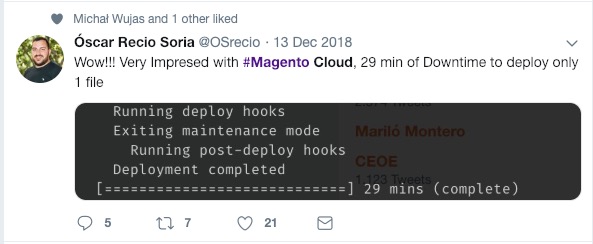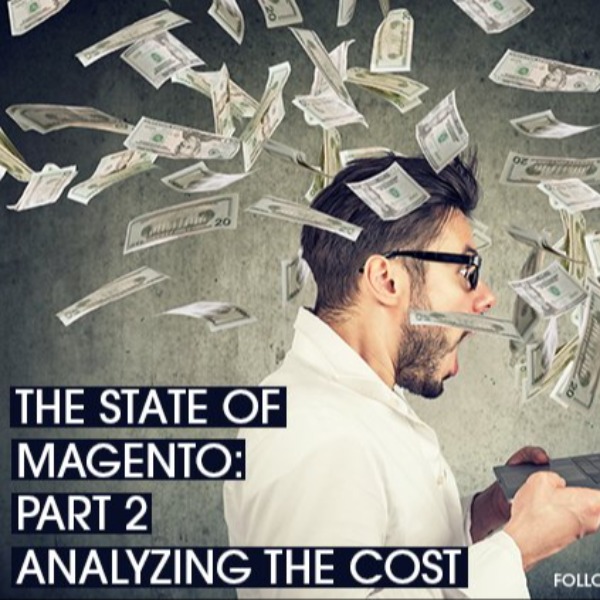

The State of Magento 2 - Part 1 - Navigating the Changes
February 1, 2019 by Paul Byrne
This article is the first in a series of three that will be released weekly. It was inspired by the increasing amount of misinformation (disinformation?) we have been hearing. Our goal is to present a clearer picture for merchants.
Part 1 (this article): Understanding the changes
Part 2: An analysis of the cost of ownership
Comparing cost of ownership and innovation for clients who have migrated from Magento 1 to Magento 2.
Part 3: The state of new features
We will discuss features released after Magento 2 core including Page Builder, Multi-source Inventory, B2B functionality, and PWA Studio. If you want to read about some of the core features see upgraded checkout and other handy upgrades.
The Magento Migration Question
Every time I encounter a merchant who runs a store on Magento 1 the topic of conversation always seems to end up with the migration question. They know that Magento 1 is sunsetting in 2020 but lack technical staff to research the pros and cons of moving to Magento 2 or changing platform brands altogether. Answering that question - and it is not an easy one - has a lot to do with the merchant’s strategy and the business context of Magento.
Let Us Speak Freely
Razoyo… is not a Magento partner…. We love many things about the Magento software and ecosystem and have clients who rely on it.
Razoyo, by choice, is not a Magento partner - we prefer to remain impartial when recommending a platform. We love many things about the Magento software and ecosystem and have clients who rely on it. However, given the pace of change in this industry and Magento’s reputation for pushing partners to abandon all others, we decided not to pursue that ball and chain.
We respect and admire a number of agencies and developers who are married to Magento. It’s a personal choice and it hasn’t kept us from contributing to community core or developing some amazing digital commerce experiences on Magento. We are certified, but we’re not partners. We hope this position allows us to be a little more objective.
The Adobe Shuffle
In case you were wondering: the investor group purchased Magento from eBay for $925M and sold for $1.68B 3 years later. Not bad.
When Adobe purchased Magento last year, there was no lack of opinion in the developer and systems integrator community. Would it be good for the Magento ecosystem or not? Speculation was expectedly rampant. The frogs in the pond are the first to chirp when a big, new element enters their ecosystem.
After sliding into the pond, Adobe immediately made some substantial structural changes. While Alan Kent, Magento’s former chief architect, left in late 2017 (pre-acquisition), you don’t have to read very far between the lines to see it was related. Shortly after the acquisition Adobe closed the Magento Business Intelligence (fka RJ Metrics) office in Philadelphia and the development office in Ukraine.
While the MBI service never really seemed to get off the ground and was a recent addition to the family, the developers in Kiev were definitely core members of the clan. I understand Adobe’s business rationale - they have much cheaper developer resources in India - we knew a lot of those people by name and by accent. Other key players, like Elena Leonova, who headed up the product management group have since made their way to other ecommerce companies (Elena is currently rocking it at BigCommerce).
Of course, this is just the tip of the iceberg and Mark Lavelle, Magento’s CEO, has escaped the guillotine — so far.
We anticipated big changes, but, many of these changes hit the ecosystem pretty hard. We reluctantly said до побачення to a lot of people we had come to trust and have felt a definite chilling in community engagement from Magento.
The Smoke Screen
From shortly before the announcement of the acquisition to now, Magento has been trying to push several initiatives into the marketplace with varying degrees of success.
Changing product names - 0y veh!
OK, can I just say that the constant shuffling of product names is the most annoying thing Magento has done? For those of you not in the know, we used to have two versions of Magento (after Pro was retired): Magento Community Edition and Magento Enterprise Edition. The names were descriptive, easy to abbreviate (CE and EE) and lasted for years. Everyone knew what you were talking about.
Magento has taken a naming system that actually made sense and made it confusing as hell.
Then, last year, Magento announced that EE would now be known as Magento Commerce and CE would become Magento Open Source. That’s all well and good, but, everyone knew the old names and the new names are nothing but confusing. First of all, both versions are open source, meaning that the source code is available and modifiable by the licensee. Both are also products used to manage digital commerce web sites. So, Magento has taken a naming system that actually made sense and made it confusing as hell.
Seriously, WTF?
Magento Commerce Cloud
Magento also introduced their cloud-hosted version known as Magento Commerce Cloud and deployed using Platform.sh. Our experience and that reported by other systems integrators and developers is that Magento is pushing Commerce Cloud hard. Every developer I’ve spoken to wishes they would stop.
… Magento is pushing Commerce Cloud hard. Every developer I’ve spoken to wishes they would stop.
It is important to clarify that Magento Commerce Cloud is NOT a SaaS platform and does not have the all the advantages or disadvantages of one. The claims I have heard being made by Magento representatives to the contrary make me want to roll my eyes.
Magento Commerce Cloud is NOT a SaaS platform and does not have the all the advantages or disadvantages of one.
There are nuances that I won’t get into here, and, while hosting your Magento store with MCC has advantages over hosting with a bad host, it is not a Shopify or BigCommerce experience. The merchant will still have to deal with upgrades and security and a host of other issues that are the domain of open source software. The amount of downtime for deploying code is also still a problem despite assertions to the contrary.

In short, Magento CC is Magento Commerce (not Magento Open Source) hosted by Magento. That’s it. The main advantage to this setup is that the Magento investors were able to convince Adobe that it now had one of the most valuable assets in tech companies - a cloud product - and make a $700M profit in the process.
But, let’s be honest with ourselves, that’s what Adobe thinks a cloud product is. You take software that the customer downloads and runs on their machine and charge a subscription for it without any real cloud features… like they did with Creative Studio, now Adobe Creative Cloud. If Adobe follows the same strategy they did with Creative Studio, Magento Open Source’s days are numbered. In the end, the user is the loser.
Magento Order Manager (MOM)
Magento started hyping its long-awaited (really? who was waiting for this?) order management system. There isn’t a lot of detail to go into here. I only know of one confirmed MOM implementation the infamous FraPort case.
Honestly, the features they were able to deliver with the system at the Frankfurt airport appear to be amazing (I have no personal experience with it). Let’s be honest, though. As it stands, MOM is more of a handle for a consulting service offered by Magento Services, than a software platform.
So, yeah, not only is Magento competing with its hosting ecosystem, its Services group is now competing with the Magento developer community.
Update: John Baxendale, chief architect of the MOM solution shared a different point of view in our Twitter exchange on the subject and I appreciate his chiming in. He contends that there are currently 40 users, the platform is a true SaaS offering and that implementations are partner-led. Creatuity, Josh and Jenna Warren’s agency also notes on their Twitter id that they are MOM-certified.
Honestly, 40 doesn’t seem like a lot to me and I’ve spoken to a lot of partners about this who feel the way I do about it but don’t feel they can go public because of their NDAs. I hope Adobe Magento clarifies this a bit at the Imagine conference.
The Shrinking Middle Class
There have been so many misstatements (intended or not) about what Magento is doing that I felt it necessary to clear up some of the smoke. Most merchants have heard those terms thrown around but lack clarity on their meaning.
To me, these moves only make sense if Magento intends to pull out of the mid-tier market and aim upstream to bigger and bigger fish. They certainly have lots of runway to work with as they are providing services to only 1/5 merchants in the Ecommerce Top 1000 and those contracts are enormous. You certainly can’t fault them for pursuing an opportunity, but a little more transparency would be more consistent with the values of the Magento community.
Resilient Magento Developer Community
Adobe hasn’t abandoned the community altogether. In fact, Magento recently added a community-based development initiative into core to manage multi-source inventory (multiple warehouses). The genesis of this initiative pre-dates the merger by over a year, but, Magento continued to support it, and, why not? Free feature development for them!
There are a lot of amazing people and thinkers in the Magento ecosystem and we see the writing on the wall. Magento is likely to leave a void in the mid-tier merchant space and you can see many SIs who, for years, lived on Magento alone adding new platforms to their portfolios.

Magento doesn’t really have any contractual obligations to its technology partners, systems integrators or merchants using CE/MOS. As far as moral obligations, that’s a tough one. Digital commerce is a fast moving field, to say the least. Its challenges were among the reasons we jumped on this band wagon of opportunity and invested in learning to customize Magento in the first place.
My prediction? We will continue to innovate on Magento as long as it makes sense for our clients and the marketplace and Magento will continue to pursue its long-term strategy. I expect there will continue to be value and alignment for a while at least.






